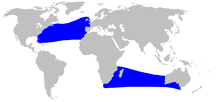True's Beaked Whale
| True's beaked whale | |
|---|---|
 |
|
| Size compared to an average human | |
| Scientific classification | |
| Kingdom: | Animalia |
| Phylum: | Chordata |
| Class: | Mammalia |
| Order: | Artiodactyla |
| Infraorder: | Cetacea |
| Family: | Ziphiidae |
| Genus: | Mesoplodon |
| Species: | M. mirus |
| Binomial name | |
|
Mesoplodon mirus True, 1913 |
|
 |
|
| True's beaked whale range | |
True's beaked whale (Mesoplodon mirus) is a medium-sized whale in the mesoplodont genus. The common name is in reference to Frederick W. True, a curator at the United States National Museum (now the Smithsonian). There are two distinct populations in the Atlantic and Indian Oceans (this species is absent in the tropics) which may be separate subspecies.
The species was first described in 1913 by Frederick W. True from an adult female that had stranded on the outer bank of Bird Island Shoal, Beaufort Harbor, North Carolina, in July 1912.
This whale has a normal mesoplodont body, except that it is rotund in the middle and tapering towards the ends. The two distinctive teeth on the males are small and set on the very end of the beak. The melon is rather bulbous, and leads into a short beak. There is a crease behind the blowhole, and a sharp dorsal ridge on the back near the dorsal fin. The coloration is gray to brownish gray on the back which is lighter below, and notably darker on the "lips", around the eye, and near the dorsal fin. There is sometimes a dark blaze between the head and dorsal fin as well. One female in the Southern Hemisphere was bluish black with a white area between the dorsal fin and tail as well as a light gray jaw and throat, as well as black speckling. Scars from fighting and cookiecutter sharks are present on males. This species reaches around 5.3 metres (17 ft) with the females weighing 1,400 kilograms (3,100 lb) and the males weighing 1,010 kilograms (2,230 lb). They are around 2.2 metres (7.2 ft) long when born.
They have been seen in small groups, and are believed to be squid eaters. Little else is known.
One population, possibly genetically distinct, lives in the Northern Hemisphere and has stranded from Nova Scotia in the western Atlantic to Ireland in the eastern Atlantic and as far south as Florida, the Bahamas, and Canary Islands. Another population lives in the Southern Hemisphere and has stranded in South Africa, New Zealand and Australia. The species does not inhabit the Southern Atlantic or Northern Indian Ocean, and appears to avoid tropical waters. No population estimates have been established, but it is believed to be one of the rarest species of whale.
...
Wikipedia

